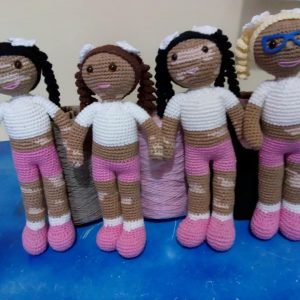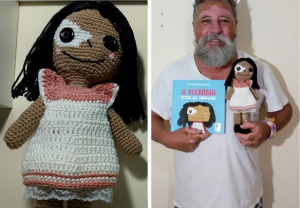João Stanganelli Junior is 64 years old. Since he was 38, his skin began to lose its pigment due to vitiligo: large white spots began to form on his body, unrelated to the natural color of his skin, because the cells responsible for the pigmentation, the melanocytes, stopped producing melanin.
For a long time, Stanganelli, originally from Santo André, in the metropolitan region of São Paulo, Brazil, worked as a cook. As he approached the retirement age, he slowed down his activities. He wanted to devote himself to something that would give him more peace of mind. His wife Marilena suggested that they start learning crochet together. They began in 2018. Stanganelli tried until he got calluses on his fingers, but once he caught on to the twists and turns of the technique he was able to complete his first project in just five days, a doll for his granddaughter Isabella: a doll with vitiligo spots for his granddaughter to remember him by.
A photo of him with the doll circulated among Stanganelli’s friends and acquaintances. It didn’t take long for them to ask him for personalized dolls.
Thus the dolls with vitiligo Vitilindas and the Vitilindos were born. João Stanganelli make them so that children living with this condition feel represented. Stanganelli makes them in the city where he lives, Bragança Paulista (another municipality of São Paulo) and from there he attends to requests.
According to the World Health Organization, vitiligo has no definitive treatment for cure and affects 1% of the world population. The psychological effect for the sufferer of vitiligo, with the dominant patterns of beauty in our societies, can be high.
João Stanganelli said in an interview with Jeremiah Rodriguez of CTV News that vitiligo has not caused him any major inconvenience, but he is empathetic to those who feel most affected, particularly children. There are people who have told him that the dolls have helped them with their self-esteem.
“My view of vitiligo seems to me to be very different from the general, I think it is necessary first that you have vitiligo, after this acceptance you choose what you want to do,” Stanganelli, on the other hand, told Bored Panda’s Mindaugas Balčiauskas and James Caunt of Bored Panda.

The story of Stanganelli and his Vitilinda and Vitilindo has traveled the world through social media and, as a result, also through interviews with outlets in Brazil and other countries. People’s requests and responses are numerous.
João Stanganelli expanded his catalogue to include dolls in wheelchairs and dolls with magnifying glasses, psoriasis and alopecia areata, an autoimmune disease that most often affects children and young people, with one or more patches of hair loss, according to the World Health Organization.
https://www.instagram.com/p/Bvy8OmwDrQ_/
Tati Santos de Oliveira wrote a book for her three-year-old daughter with vitiligo, “A Girl Made of Clouds”. In the story, the main character has a special secret: she has spots made of clouds. With this, the author wanted to treat the acceptance of vitiligo with delicacy, she told the journalists of Boredpanda.
Stanganelli made a crocheted doll who embodies the menina of the book.

João Stanganelli continues to work in cooking, but with less intensity, he said in the interviews. He says that, despite the calluses on his fingers, he won’t stop making the crocheted dolls because of “the joy he feels from people reaching out,” according to the CTV News reporter.
